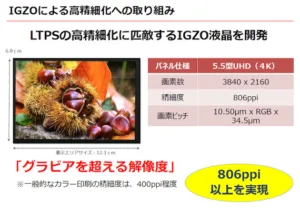News of an expected high resolution display from Sharp broke today and was picked up by many techblogs and news outlets. According to the various articles, the new panel is based on IGZO technology and should be mass produced by 2016. The 5.5″ panel has a resolution of 3840 x 2160 and is therefore a UHD/4k panel. By strict definition, it is a UHD panel but it is also labeled in the various rumors as a 4k panel.
The news is supported by a few Powerpoint slides that show a description of the panel, as shown below.
Source: Techblog.cr
As far as the images are concerned, this makes sense but the slides do not contain a logo to identify them as being from Sharp. This raises at least some suspicion about the authenticity of the images. Most articles about this topic point to each other as the source, and it would appear that Techblog.cr broke the news first. We also also asked Sharp for confirmation, but so far we have not had a response.
Analyst Comment
While the news may be a belated April Fools news joke, the trend is definitely going in this direction and I would not be surprised if this turns out to be correct. Several players have phablets with QHD resolution in the market already and the next step up would of course be UHD/4k resolution.
Most articles are somewhat surprised and subscribe to the view that this may be a step too far in the specification centric marketing push within the smartphone industry. I do not subscribe to the idea that better specifications make better devices as the market shows year after year. Nevertheless, UHD/4k display panels for mobile phones will come to market and the consumer will have to decide if this will be a success or not.
From a technical perspective, most will argue that such a display is ‘past retina’, meaning that people can’t see any differences. Since the term retina display means that this is the limit of human visual acuity, they have a point here. Looking at the display we have to recognize that the visual acuity is based on an angle, typically noted as one arc minute for a person with average vision of 20/20 or 6/6. If we use angles as the basis of visual acuity, we notice that the distance to the display panel is as important as the actual pixel distance in the question if we can distinguish between two pixels or not. The following chart tries to show exactly this relationship, by plotting the pixel density that a person with average vision should be able to resolve pixels ,versus the observation distance.

The two curves show how people with different visual acuity can resolve pixels as a function of distance. Since a 20/20 (6/6) vision is often seen as the norm, the lower curve shows that you need to be closer than 5″ (12.5cm) from the display to see pixels in a 5.5″ UHD panel. However, some data suggest that many people actually have better vision than that and at 20/10 (6/3) vision you need to only focus at a distance of about 10″ (25cm) to resolve pixels. In other words, it depends strongly on the person’s ability to focus if such a panel makes sense or not. Surprisingly, there are people out there that could benefit from a 5.5″ UHD/4k panel in a mobile device. Since visual acuity and focus ability deteriorates with age, this will mainly make sense for younger people, which also happen to be the most important customer for smartphones already. It seems such a display may make sense after all, even though I strongly suspect that the strongest reason for bringing such displays to market is still marketing bragging rights. – NH

